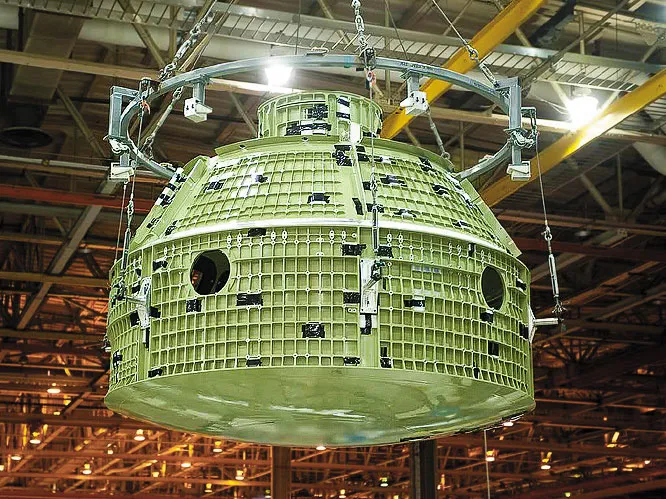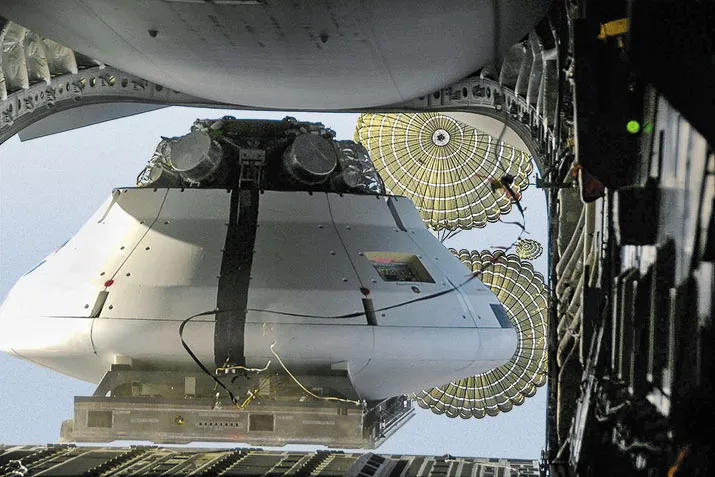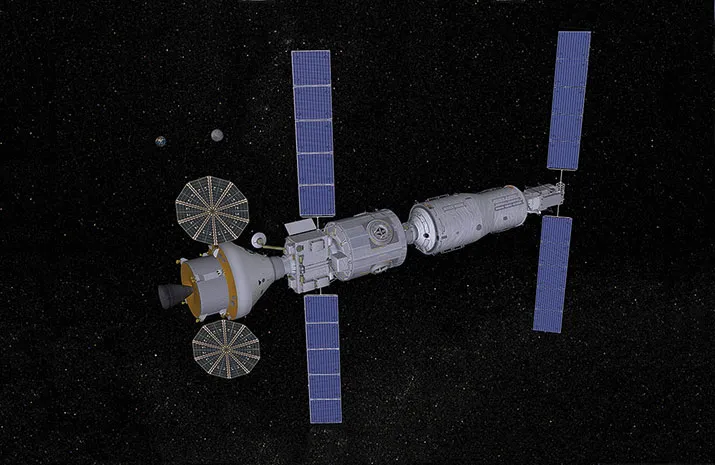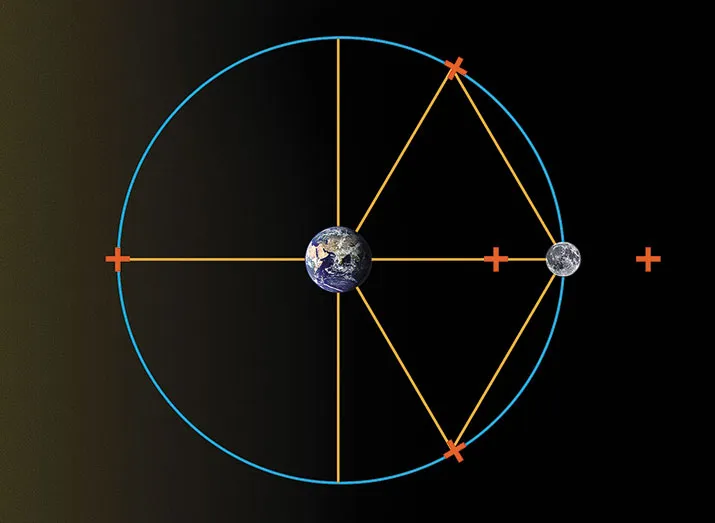NASA Aims to go Beyond the Moon
It’s not a place, exactly. But it could be NASA’s next destination.
/https://tf-cmsv2-smithsonianmag-media.s3.amazonaws.com/filer/Beyond-Moon-Space-631.jpg)
The late summer of 2011 was an awkward moment for NASA’s 50-year-old spaceflight program. The space shuttle’s final mission had just ended, and construction of the International Space Station—the shuttle’s signature achievement—was complete.
A year earlier, President Obama had, to the dismay of Congress, cancelled the shuttle’s presumptive follow-on program: a return to the moon. “We can’t keep on doing the same old things,” Obama had said in a speech at Florida’s Kennedy Space Center. “We’ve been there before.”
Instead, he set a new goal—sending astronauts “beyond the moon,” to an asteroid by 2025, then on to orbit Mars by the mid-2030s. Critics who accuse NASA of having no destination for human spaceflight couldn’t be more wrong, according to the agency. “The ultimate destination is to send people to the surface of Mars,” says Doug Cooke, who in 2011 was NASA’s associate administrator for exploration systems (he is now an independent aerospace consultant). The choice of Mars is clear, in part, because anything more ambitious is simply beyond today’s technology. “That’s about as much as we know how to do,” says Cooke.
But as Cooke and everyone else in the NASA hierarchy well knew, we’re not ready for Mars. So the task in 2011 was to plan out the intermediate steps. NASA had been mulling an asteroid mission for years (see “The Million-Mile Mission,” June/July 2008), but as the studies got more detailed, difficulties arose. It became apparent that there were very few good targets to visit in the 2020s. NASA needed an asteroid that was both reachable and “interesting.” Interesting, in scientific parlance, meant “something big enough to have some diversity of features, at least 60 or 70 meters in any dimension,” says Cooke.
Reachable meant finding a target that NASA could handle with a short (months-long) trip, for not too much money. Traveling to an asteroid “can be as difficult as landing on Mars,” Cooke says, “and it’s comparable in transit times and what it implies for crew conditions and habitat.” Some targets would be easier to reach, but the pickier you get for scientific or logistical reasons, “the fewer asteroids there are to choose from.”
The plan had even bigger problems. Hardly anyone wanted to do it. A report by a National Research Council panel on NASA’s strategic direction last December was blunt by Washington standards: “The committee has seen little evidence that a current stated goal for NASA’s human spaceflight program—namely, to visit an asteroid by 2025—has been widely accepted as a compelling destination by NASA’s own workforce, by the nation as a whole, or by the international community.” Furthermore, even though the panel wasn’t asked to assess the plan’s technical feasibility, “it was informed by several briefers and sources that the current planned asteroid mission has significant shortcomings.”
Shelving the asteroid option would leave NASA’s new spaceship, Orion, and its planned shuttle-derived rocket, the Space Launch System, with nowhere to go, at least in the near term. By 2017, the SLS will be ready to launch an unmanned Orion—the shuttle’s successor—into Earth orbit on the spacecraft’s second test flight. Four years after that (the slow pace is dictated by NASA’s declining budget), astronauts plan to board Orion for the first time, to (perhaps) circle the moon and return. NASA could handle such a demo flight easily, Cooke says, but would prefer to try something “more meaningful.”
That more meaningful something emerged during 2011 in a proposal known as Gateway. The mission: Send astronauts to an empty spot in space, high above the lunar far side, where the gravitational pulls of Earth and of the moon are balanced. Such spots are called Lagrange points; the one in the Gateway proposal is Earth-moon Lagrange 2, or EML-2 (see “The Lagrange Points,” p. 27). Circling this spot in a “halo” orbit, an astronaut crew would remain effectively parked in zero gravity, flying in formation with the moon as it orbits Earth every 27.3 days.
At the L2 point, astronauts could learn to work in deep space. They could joystick a robotic rover to explore the craters, hills, and valleys of the lunar far side, 40,000 miles away. They could use the rover to deploy a sensitive radio telescope that would be shielded from terrestrial interference. Biologists could gather critical data on the dangers of galactic cosmic rays, which can increase the risk of cancer, to future deep space travelers. Eventually, the L2 point could serve as a staging site—a gateway—for missions to asteroids and to Mars.
Gateway’s primary advantage, though, may be economic and political. A mission to L2 would send astronauts farther than they’ve ever been, using hardware already under construction. No expensive landers or long-duration spacecraft would be required. Advocates say it would be a worthy interim goal—far enough to push astronauts and their technology, but, at least in theory, close enough to bring them home in case of emergency. It’s both challenging and possible. And, says John Logsdon, former director of the Space Policy Institute at George Washington University, Gateway’s “initial beauty is that it is a reachable destination that’s new.”
***
Although NASA has been studying Lagrange-point missions for at least a decade, the idea gained new momentum in August 2011, when William Gerstenmaier, NASA’s associate administrator for human exploration and operations, created a special working group to examine NASA’s human spaceflight options. Affordability was a primary requirement, and for space mission planners, a sure way to lower launch costs is to cut down on the consumable supplies, especially fuel, a crew needs to take along. A principal advantage of any Lagrange point is that once a spacecraft arrives, very little energy is required to keep it there. “I’m using the gravity properties to minimize the fuel requirements,” Gerstenmaier says.
The L2 point is about 15 percent farther than the Apollo astronauts traveled. The quickest way to get there—in only three to five days—is to use the Apollo approach: take aim and fire. This, however, requires extra fuel. So NASA would prefer to take a slower and more circuitous route, using a gravity assist from the moon to hurl Orion to its destination.
“This is a trick that NASA has been using in robotic missions for the last 40 years, but it would be the first time for human spaceflight,” says University of Colorado space scientist Jack Burns, director of the NASA-funded Lunar University Network for Astrophysics Research, who has been studying options for L2 missions. “We’re talking a week to get to L2 because of the gravity assist and the resulting trajectory.”
By early last year, Gerstenmaier’s in-house NASA group had worked up a PowerPoint prospectus on a Gateway mission, emphasizing its value as a training ground for deep space. Astronauts would gain critical experience operating their spacecraft in a new and unfamiliar environment beyond Earth orbit, would use dosimeters to monitor radiation levels, and would work more independently of Earth-based controllers. All this could be done from Orion, which will be about two and a half times roomier than the Apollo spacecraft and weigh nearly 11 tons, almost twice Apollo’s weight. With its European-built service module, it will carry four astronauts instead of Apollo’s three.
For an L2 mission, Orion wouldn’t simply fly to the far side of the moon and park at the Lagrange point. Instead, the spacecraft would be placed in a halo orbit around L2. “You set it up so you can always see the Earth,” says Josh Hopkins, Lockheed Martin’s space exploration architect and a close collaborator with the Burns team in Boulder. Hopkins describes the preferred orbit as asymmetrical, its dimensions and shape dictated by the changing gravitational forces at L2. The orbit would have a radius of 22,000 miles east to west, and 3,000 to 6,000 miles north to south. It would not quite lie in a flat plane, Hopkins adds. “It looks like a Pringles potato chip.”
A spacecraft in this orbit requires very little fuel compared with the space station, which needs regular burns to overcome the drag of Earth’s atmosphere, and occasional tweaks to steer it past space junk. At L2, the only real problem would be a tendency for the spacecraft to drift. “If you start out a little behind L2, the moon pulls you back,” Hopkins says. “You need very small bursts of energy to keep station.”
This, Gerstenmaier says, “may be more complicated than it looks.” An L2 orbit “is a little bit of a trade-off,” he explains. “From a propellant standpoint, it’s easy, but we don’t have a lot of experience navigating around a gravity point.”
Besides mastering the orbital mechanics of deep space, the Gateway astronauts would have work to do. In a recent paper for the journal Advances in Space Research, the Burns group described some possibilities, beginning with a first-ever comprehensive robotic exploration of the far side of the moon. This mission would begin with the landing of an unmanned rover in the South Pole–Aitken basin, a favored target for geologic exploration because it offers a broad swatch of lunar history. The basin includes some of the oldest rocks on the moon, but there also is evidence of more recent volcanism.
Orion, with astronauts on board, would arrive at L2 after the rover lands. With a signal delay of only 0.2 second (it takes about two seconds for a signal to travel from Earth to the moon), astronauts could steer the vehicle in near-real time. “We’re talking about a surface rover that can move kilometers in a day instead of meters,” Burns says.
Astronauts could also use the rover to deploy an array of antennas for a radio telescope. Shielded by the moon from Earth-generated radio interference and ionospheric distortion, the far-side telescope could examine the formation of the first stars, 85 million to 250 million years after the Big Bang.
The Burns team envisions a month-long L2 mission, limited in part by concerns about galactic cosmic rays, high-energy particles from outside the solar system. The effects of cosmic rays on human tissue are neither beneficial nor well understood, and radiation is currently a show-stopper for expeditions to Mars. An L2 mission offers opportunities to study the hazards of radiation without risking a lethal dose. “Six months to a year is the limit,” says Lockheed Martin’s Hopkins. “The best way to avoid the effects of radiation is not to stay out in space too long.”
Month-long Gateway missions could be done with Orion alone. Beyond a month, “you need an outpost,” Hopkins said during a recent briefing to a National Research Council panel on technologies for human spaceflight. According to Hopkins, Lockheed and other “major space industry players” from around the world have been meeting to discuss future exploration plans and “talk about what could we do together”—an informal parallel to the official planning exercises at the national space agencies. “L2 outposts and lunar surface mission support popped out as a logical thing to do for a couple of reasons,” Hopkins told the NRC. “One is that because L2 is easy to get to, it’s something that other countries can contribute to, using the assets they already have…. The other reason was that there’s a lot of different things you can do from L2, so you don’t have to agree on why we’re going before you go there.”
If the Gateway outpost were to grow, the Burns group has thought about placing a storage depot there, “something modest, stocked with consumables,” he says. Astronauts would have extra lab space and “more room to maneuver,” he adds. Orion could dock with the depot and have a small, reusable lunar lander berthed there. Burns says the depot would most likely use modules similar to those on the space station.
With this infrastructure or something more elaborate, astronauts, at least in theory, could also use L2 as an orbiting tank farm, mining ice robotically from the lunar poles or taking water extracted from asteroids and converting it to hydrogen and oxygen—the basic components of rocket fuel. NASA has said nothing specific about mining ice, but “as we push out, we’re going to try to take advantage of whatever resources are there,” Gerstenmaier says. “If it’s there, we’re going to figure out a way to do it, it makes sense.”
The L2 Gateway idea has its critics. Some can’t accept a spot in empty space as a legitimate destination. Lunar expert Paul Spudis, a staff scientist for the Lunar and Planetary Institute in Houston (and Air & Space blogger), worries that sending astronauts to L2 will do nothing to build a durable human presence in deep space. He characterizes the mission as a NASA “one-off,” with little value beyond “getting people to L2 and figuring out something for them to do.”
Long an advocate of harvesting lunar water to fuel a transportation system in the Earth-moon neighborhood, Spudis regards NASA’s failure to emphasize that goal as evidence of the agency’s shortsightedness: “If you want to build a space system, you have to learn how to extract resources from the moon,” he says. “There is water ice on the moon and it can be accessed, but the [L2] mission is not long-term. It is configured as a place for Orion to go, not as a place to build a capability.”
Hopkins agrees that L2 is a short-term mission, but doesn’t see that as a negative. “We don’t envision a long-term commitment to infrastructure at L2,” he told the NRC panel. “We would envision a series of missions to do a few things, then move on to the next destination.”
As to whether any of this will actually happen, NASA can’t be sure. In January, when a reporter asked Gerstenmaier where he’d like to send Orion after its initial tests, he smiled and answered like a diplomat: “In terms of my own personal preference, I really don’t have one…. I try to lay out the data and let them [Washington officials] decide.”
All he can say for sure is that next year, a Delta 4 rocket is slated to fire an unmanned Orion 3,600 miles into space, then after two orbits bring it back at 20,000 mph to see if its heat shield can endure 4,000-degree Fahrenheit reentry temperatures. A second unmanned launch of Orion, aboard the Space Launch System, is planned for 2017, and a crewed mission is scheduled for four years after that. Gerstenmaier says the 2021 flight will travel to “the vicinity of the moon,” which includes several possibilities: going into lunar orbit, traveling straight to L2 and returning, or going to L2 and perhaps sliding to L1, on the near side of the moon. (Travel between Lagrange points is easy, requiring little more than a nudge in the right direction.)
Meanwhile, the planners keep planning. Maybe the most dramatic use of an L2 outpost is one proposed by the Keck Institute for Space Studies in cooperation with NASA’s Jet Propulsion Laboratory in California. They describe a mission in which a robotic spacecraft chases down a schoolbus-size asteroid, captures it, and brings it to the vicinity of the moon. There, astronauts could practice spacewalking around a small asteroid, extract water to make rocket fuel, and take inventory of its minerals.
The notion of capturing and relocating a half-million-pound asteroid began “as one of those ideas that when you first tell somebody about it, they look at you with glazed eyes,” says Louis Friedman, executive director emeritus of The Planetary Society and a co-leader of the study. “Then you get into it, and all of a sudden it becomes obvious to people that this is the only way to get astronauts to an asteroid in the 2020s.” Friedman says NASA has taken a serious interest in the proposal, and the agency said in a statement that it is examining the plan “to determine its feasibility.”
“The gut feeling is that we like L2, but it turns out that if an object is at L2 and let go, it will be unstable and could drift away” and possibly crash to Earth, Friedman says—although an object as small as this 23-foot-wide asteroid would burn up in the atmosphere. One problem is finding the right asteroid, he says. There are “millions out there,” but NASA and its international partners would need to set up a dedicated program to shop for candidates of the right size and type. The robot spacecraft would approach the asteroid, match its tumbling motion, and use a soft, inflatable bag in the spacecraft’s nose to grab it. Then the spacecraft would “de-spin” the asteroid and bring it near the moon. The entire capture mission would take anywhere between five and a half and 10 years, depending on the asteroid’s initial orbit and its mass.
As of early this year, NASA has not committed to an L2 mission. “The Lagrange points are very intriguing to us,” Gerstenmaier says, but adds that Gateway might turn out to be more challenging than it seems. “We need to know if there are too many unknowns. Am I not pushing hard enough? Or am I pushing too hard?” The most likely message to NASA from space enthusiasts? Push.
Guy Gugliotta, a former science reporter for the Washington Post, is the author of Freedom’s Cap: The United States Capitol and the Coming of the Civil War (Hill and Wang, 2012).




